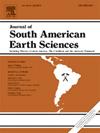The role of multiple disturbances in the morphodynamics of an alluvial fan in the north Patagonian Andean forests, Argentina
IF 1.7
4区 地球科学
Q3 GEOSCIENCES, MULTIDISCIPLINARY
引用次数: 0
Abstract
Alluvial fans have the potential to record climatic and neotectonic events. These depositional systems, characterized by distributary river patterns, are more frequently studied in arid environments due to better exposure and easier accessibility. In this study, we applied dendrogeomorphic methods on an alluvial fan within the wet temperate north Patagonian Andean forests to reconstruct the environmental history of the Derrumbe Creek Alluvial Fan. The specific objectives were: (a) to date the activation/inactivation of different ecogeomorphic units in the alluvial fan, and (b) to interpret the relative importance of various disturbances that have shaped its recent history. The Derrumbe Creek Alluvial Fan is located in the southern bay of Puelo Lake, in the northwest of Chubut Province, Argentina. We carried out two fieldwork campaigns for tree data collection and geomorphic analysis. Using standard dendrochronological laboratory methods, we obtained establishment dates for the different geomorphic units of the alluvial fan and developed a disturbance chronology. Three main disturbance events were identified: the first in the early 1920s, clearly associated with a fire; the second between 1957 and 1959, linked to sediment deposition (colmatation) and lateral migration of the active channel; and the third between 1961 and 1963, related to an outburst flood and avulsion of the active channel. We propose that the latter two disturbance events were facilitated or conditioned by the earlier fire, emphasizing the significance of fire history in the geomorphic evolution of the alluvial fan. Our findings highlight the role of multiple disturbances in the complex dynamics of alluvial fans in the southern Andes.
求助全文
约1分钟内获得全文
求助全文
来源期刊

Journal of South American Earth Sciences
地学-地球科学综合
CiteScore
3.70
自引率
22.20%
发文量
364
审稿时长
6-12 weeks
期刊介绍:
Papers must have a regional appeal and should present work of more than local significance. Research papers dealing with the regional geology of South American cratons and mobile belts, within the following research fields:
-Economic geology, metallogenesis and hydrocarbon genesis and reservoirs.
-Geophysics, geochemistry, volcanology, igneous and metamorphic petrology.
-Tectonics, neo- and seismotectonics and geodynamic modeling.
-Geomorphology, geological hazards, environmental geology, climate change in America and Antarctica, and soil research.
-Stratigraphy, sedimentology, structure and basin evolution.
-Paleontology, paleoecology, paleoclimatology and Quaternary geology.
New developments in already established regional projects and new initiatives dealing with the geology of the continent will be summarized and presented on a regular basis. Short notes, discussions, book reviews and conference and workshop reports will also be included when relevant.
 求助内容:
求助内容: 应助结果提醒方式:
应助结果提醒方式:


